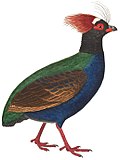Gallopheasant
| Gallopheasants | |
|---|---|

| |
| Lophura swinhoii - Swinhoe pheasant | |
| Scientific classification | |
| Domain: | Eukaryota |
| Kingdom: | Animalia |
| Phylum: | Chordata |
| Class: | Aves |
| Order: | Galliformes |
| Family: | Phasianidae |
| Tribe: | Phasianini |
| Genus: | Lophura Fleming, 1822 |
| Type species | |
| Phasianus ignitus Shaw, 1797
| |
The gallopheasants (genus Lophura) are pheasants of the family Phasianidae.[1] The genus comprises 11 species and several subspecies. Several species in this genus are known as firebacks, including crestless and crested firebacks, as well as the Siamese fireback.
Taxonomy
[edit]The genus Lophura was introduced in 1822 by the Scottish naturalist John Fleming to accommodate a single species, the Bornean crested fireback (Phasianus ignitus Shaw, 1798) which is therefore considered to be the type species by monotypy.[2][3] The genus name combines the Ancient Greek λοφος/lophos meaning "crest" with ουρα/oura meaning "tail".[4]
Species
[edit]The genus contains the following 11 species:[5]
| Image | Name | Common name | Distribution |
|---|---|---|---|

|
Lophura edwardsi | Edwards's pheasant | Vietnam |

|
Lophura swinhoii | Swinhoe's pheasant | Taiwan |
 |
Lophura bulweri | Bulwer's pheasant | Borneo |

|
Lophura leucomelanos | kalij pheasant | Pakistan to western Thailand |

|
Lophura nycthemera | silver pheasant | mainland Southeast Asia, and eastern and southern China |
 |
Lophura erythrophthalma | Malayan crestless fireback | Malay peninsula and Sumatra |
 |
Lophura pyronota | Bornean crestless fireback | northern Borneo |

|
Lophura rufa | Malayan crested fireback | Thai-Malay Peninsula and Sumatra |

|
Lophura ignita | Bornean crested fireback | Borneo |

|
Lophura diardi | Siamese fireback | Cambodia, Laos, Thailand and Vietnam in Southeast Asia |
 |
Lophura inornata | Salvadori's pheasant | Sumatra |
Lophura hatinhensis and Lophura hoogerwerfi are sometimes considered subspecies, leaving this genus with only 11 species.[6][7] Other subspecies are also sometimes considered distinct species.
- Lophura × imperialis - imperial pheasant[8]
References
[edit]- ^ "Lophura Fleming, 1822". www.gbif.org. Retrieved 2023-02-22.
- ^ Fleming, John (1822). The philosophy of zoology, or, A general view of the structure, functions, and classification of animals. Vol. 2. Edinburgh: Hurst, Robinson & Co. p. 230.
- ^ Peters, James Lee, ed. (1934). Check-List of Birds of the World. Vol. 2. Cambridge, Massachusetts: Harvard University Press. p. 117.
- ^ Jobling, James A. "Lophura". The Key to Scientific Names. Cornell Lab of Ornithology. Retrieved 15 February 2025.
- ^ Gill, Frank; Donsker, David; Rasmussen, Pamela, eds. (August 2024). "Pheasants, partridges, francolins". IOC World Bird List Version 14.2. International Ornithologists' Union. Retrieved 15 February 2025.
- ^ Hennache, A; Mahood, SP; Eames, JC; Randi, E (2012). "Lophura hatinhensis is an invalid taxon". Forktail. 28: 129–135.
- ^ "Lophura [inornata or hoogerwerfi] (Salvadori's or Sumatran Pheasant) - Avibase". avibase.bsc-eoc.org. Retrieved 2023-02-22.
- ^ Hennache, A; Rasmussen, P; Lucchini, V; Rimondi, S; Randi, E (2003). "Hybrid origin of the imperial pheasant Lophura imperialis (Delacour and Jabouille, 1924) demonstrated by morphology, hybrid experiments, and DNA analyses". Biological Journal of the Linnean Society. 80 (4): 573–600. doi:10.1111/j.1095-8312.2003.00251.x.




